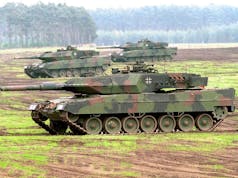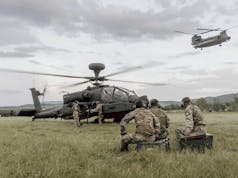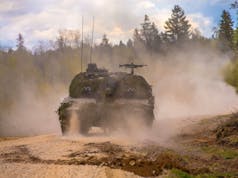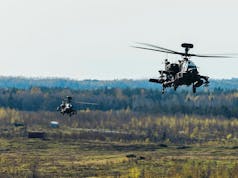QinetiQ North America and Pratt and Miller Defense are partnering on the Robotic Combat Vehicle (RCV) programme.
QinetiQ North America (QNA) and Pratt & Miller will submit a variant of the Expeditionary Modular Autonomous Vehicle (EMAV) tailored to the Robotic Combat Vehicle program’s specific requirements, say the firms.
“The Robotic Combat Vehicle submission will leverage QNA’s modular open architecture unmanned ground vehicle control systems integrated with Pratt & Miller’s advanced mobility platform. The resulting system is a robust non-developmental solution demonstrated to fulfill the Government’s required attributes. The RCV base platform has been proven through direct warfighter experimentation to be agile, powerful, and highly reliable.”
“QinetiQ North America has focused on fielding advanced technical solutions to help our military counter emerging threats for over 25 years,” stated QNA’s President Jeff Yorsz.
“We are excited to team with a company that has equal passion of providing groundbreaking real-world solutions to our warfighters.”
Pratt & Miller Defense say it specialises in the development and manufacturing of advanced vehicles and systems for the demanding requirements of the military.
Matt Carroll, Pratt & Miller CEO, said in a release:
“Our combined cultures of innovation and expertise in supporting the warfighter will provide the US Army with a mature world class solution for the RCV program.”













I’m a firm believer in this, and I think we will see some serious leaps and bounds in practical development in the next few years. So many uses for unmanned ground vehicles, some already in service or trialled, but not many versions which can deliver a practical, tactical kinetic effect.
The Australian Army’s 9th Force Support Battalion and 2nd General Health Battalion fielded six Mission Adaptable Platform Systems (MAPS) at the Talisman Sabre 2019 training exercise in July 2019.
MAPS is a medium-sized semi-autonomous unmanned ground vehicle (UGV) developed by Australian company Praesidium Global for the ADF.
Missions include ISR, cargo and equipment transport, route clearance, casualty evacuation, tactical resupply and fire support.
The baseline MAPS is a 6×6 platform integrating plug and play systems, including a recharge generator and an additional battery pack, an acoustic gunshot detection system and can carry payloads of more than 500kg.
It can be fitted with a R400S Mk2 remote weapon station carrying a lightweight 30mm ATK M230 LF cannon or small hydraulic crane in the resupply role.
http://images.defence.gov.au/20190711adf8518511_002.jpg
We better buy some!
Some of these things mixed in with an infantry battalion, with Martlet missiles also.
BAE Systems Australia and the Australian Army have converted two M113 AS4 APCs using autonomous technologies developed by the company in Australia.
The optionally crewed combat vehicles (OCCV) have conducted fire and manoeuvre demonstrations alongside crewed AS4s of the 3rd/4th Cavalry Regiment, School of Armour at the Majura training area outside Canberra.
A Trusted Autonomous Systems Defence Cooperative Research Centre (CRC) was set up in 2017 under the Next Generation Technologies Fund. BAE Systems is the industry lead for Land Autonomy.
Following the demonstration, the optionally crewed M113 AS4 will be available for other CRC partners to use as test and demonstration vehicles.
There are some 259 relatively recently upgraded M113AS4 variants (new engine, drive train, electrical, fuel systems with stretched hulls and additional road wheels) about to be retired as they are replaced by new IFVs under Land 400 phase 3.
With the M113AS4, the ADF is in the fortunate position to have a ready-made pool of light armoured vehicles to develop unmanned platforms and their CONOPS.
The M113AS4 ALV armoured logistics vehicle tray back (ute) version is a particularly useful platform for resupply, NLOS missiles and loitering munitions.
Though not heavily armoured by today’s standards the M113AS4 is air transportable by C130, with a single Canberra class LHD able to transport 8 at a time (2 per LLC) from ship to shore.
Unmanned ground vehicles could make up the first wave of future amphibious landings in heavily contested scenarios.
http://images.defence.gov.au/20191031adf8567820_011.jpg
I am always amazed at how everyone says this will be the next big thing. Russia have actually used in combat a remote controlled ground vehicle in Syria and even they admitted it was a failure.
The main reason was due to interrupted communications when operating in a built up areas. They decided to use a line of sight data-link which was supposed to have a range of a couple of kilometres. But operating around buildings this dropped to 300m. They would have used satellite comms but believed the US was jamming them.
The Uran-9 mini-tank was armed with a 30mm auto-cannon, a 7.62 machine gun and four wire guided anti-tank missiles. Another of the issues they said the operators suffered was the lack of situational awareness (no 3rd party god mode) so they couldn’t tell immediately what was happening around them. The tank has a fixed forward view camera and another thermal/IR/optical camera mounted on the turret that is slaved to the main gun. The operators struggled to define targets especially as its presented in 2D.
So what’s the lessons learned from this? One is that when your satellite communications is compromised, it severely limits the capability of the system to act remotely. Line of sight control in built up areas is severely limited and restrict the range between the vehicle and operator. There need to be a better method of showing the surroundings to the operators probably using virtual reality or augmented reality (more cameras and operating in 3D). I know this is the start of an onward journey with unmanned vehicles and in time they will become indispensable. At the moment I don’t believe we are there yet as the command and control of the vehicles is not robust enough.
Davey, I have to say, having used quite a bit of Russian kit, it’s never that good anyway! It’s all bluff and bluster. Any use of a unmanned ground vehicle has to have operational limits attached. We are only beginning the journey to a truly autonomous ground combat vehicle, and in an asymmetric environment it is still to early for it to be a reliable concept, with no vehicles currently able to operate so. But, as someone who has experience in combat of air and ground unmanned surveillance, it will be a game changer when the concept is fully operational, and we can go at least, at the first stages, static kinetic.
Manoeurve warfare, is always dynamic, fast changing and hard to read and plan for, and you are absolutely correct that the C&C is not yet there, and situational awareness can be hard to maintain even for someone actually there, never mind reading it through a couple of cameras! But I am a firm believer of the concept, and if I can use mechanical means to get the job done, reduce my casualties and therefore remain combat effective, then I’d even get the bloody things a drink in the pub!?” Cheers mate have a good evening!
It seems like a lot of the issues can be worked around using them in combo with small drones.
The drones could provide a better 360 degree field of view to give the situational awareness and also be used to bounce the signal off to avoid buildings getting into the way. Small drones are also difficult to shoot down as they are well small and don’t have a massive heat signature.
They could also use signal repeaters which the ground troops could lob or fire into position.
However my guess is the early versions won’t be used remotely but will be used along side the boots on the ground, directly controlled from close by. Effectively used as transport and heavy firepower lift, which the design in the picture seems to suit nicely. You could have say a boxer carrying the troops and a pair of these following it, to give some serious firepower without making the boxer too heavy to be air lifted.
I think ideally you would want these to be air dropped, so you could provide heavy firepower support to units that need it.
however the biggest problem that is never really talked about is price. The only way that these will be useful is if they can be put into places where it is too risky for a manned vehicle and so they have to be cheap or they will be too expensive to risk.
Pretty much spot on, we have trialed and used a version which replaces the CSM and Plt Sgt and his quad bike and trailer (which came in during Herrick as combat loads were getting ridiculous and ammunition was being used at a fast rate of knots) which is controlled by lads at platoon level. It had issues but as a load carrier easier to use and adapt.
The issue is when you need an unmanned ground vehicle to go kinetic, then you are correct, initially it would be a static type weapon carrier, activated remotely or by human observation and command, easier and simpler, as at this time we don’t have the C&C to effectively control the vehicle while still maintaining situational awareness during combat. The use of a small UAV, drone could assist but this things alone can be time consuming and hard to operate. The DH 111 is a possibllty as it has numerous modes of operation and has an auto pilot which flys a set track allowing the operator to concentrate on the ground situation at hand. Lots to do really to get it all the ground UV up and running but it will happen and it will be pretty exciting times to see what develops mate.
I agree, the quad bike and trailer was a lifesaver for two reasons the amount of extra ammo it could carry, but also when used for casevac and you had to get to a clear area for medevac. Granted you can use two blokes to stretcher someone, but if its more than half a click away, they’ll be blowing out of their ar*** pretty quickly. Putting the stretcher on the trailer, although you feel every bump along the way, was much quicker. It is also pretty noisy, being a single cylinder foul stroke.
I’m basing my judgement on experience of working with the EOD teams (both Canadian, US and UK) and observing their robots. The best way to describe them was clunky. I think it’s because they didn’t have suspension and they didn’t give the operator any haptic feedback. So small movements could be over-exaggerated.
We had a Desert Hawk, never tried the small nano copter thing. It helped, but the camera resolution wasn’t great and not much use at night. Today’s technology should be making it more useful, the one thing I’d require, is that its given at least a decent IR camera for night work. Though I believe the version the Artillery has does have this?
An unmanned air vehicle is much easier to control than a ground vehicle. For starters you don’t have buildings or local topography getting in the way. A ground vehicle will always suffer from these issues. There must be an option for the vehicle to be controlled without using a satellite or high altitude aircraft acting as the relay. A cable would be pointless as it could too easily be damaged or cut. So that leaves some form of direct radio command. Broadly speaking, the building’s material will absorb or reflect radio signals at a different rate, this is called building loss. Building loss increases with frequency, i.e. higher frequency signals will experience a greater reduction in signal strength when passing through an object than lower frequency signals. So generally speaking HF, VHF and the lower end of UHF is best. Higher SHF frequencies as used for 3, 4 and 5G mobile phones will suffer the most. The problem now, is that if you use a lower frequency the amount of bandwidth you require for two-way data is going to be huge. Which probably isn’t a concern during a conflict, but will be during peacetime.
I do think a unmanned ground vehicle will be part of the infantry’s future and given time will be seen as a force multiplier. We just need to stop getting ahead of ourselves, until the concept is proven, especially during combat. What would be required, well that’s easy = Section support vehicle fitted with GMG, 81mm mortar, GPMG, ATGM, a bag carrier, an ammo mule or section recce vehicle the list goes on…
another option could be something like an illumination flare with a small parachute but instead of the flare use a signal booster/relay.
If they can build the relay’s cheap enough (should be possible based on commercially available products are cheap), then you could also use something like a modern crossbow to fire the relays onto building roofs.
Just needs a bit of creative thinking to work out how to get signal boosters into place.